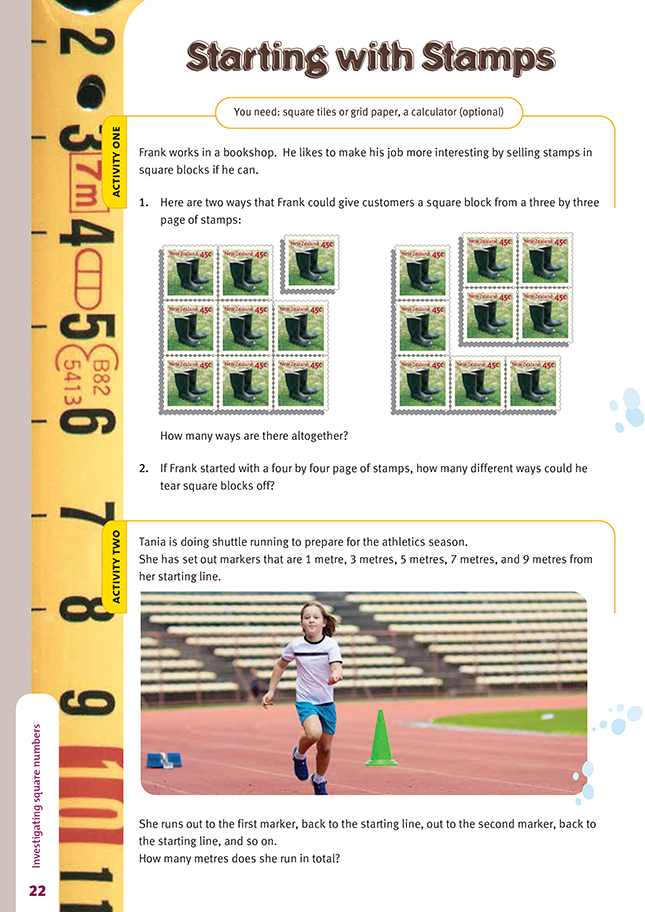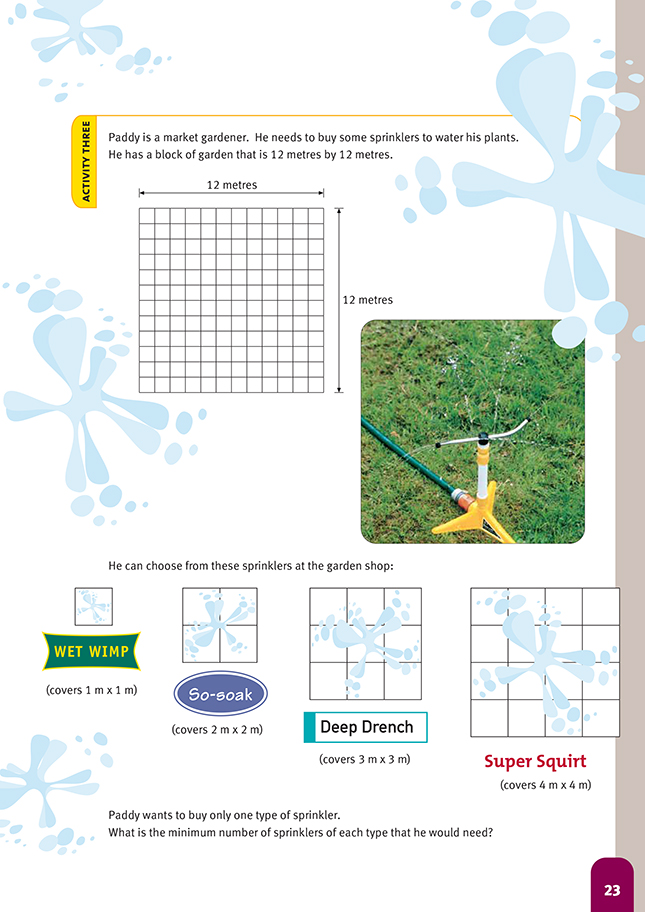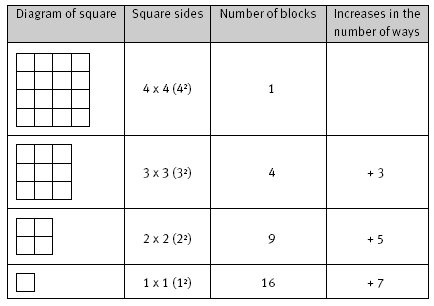This is a level 5 number link activity from the Figure It Out series. It relates to Stage 8 of the Number Framework.
A PDF of the student activity is included.
Click on the image to enlarge it. Click again to close. Download PDF (330 KB)
investigate square numbers
Square tiles or grid paper
FIO, Link, Number, Book Four, Starting with Stamps, pages 22-23
A calculator (optional)
Activity One
In this activity, students are able to use their knowledge of squares and number patterns and use spatial visualisation to solve the puzzle. Some students may think that three ways must be the answer to question 1 because 12, 22, and 32 are the types of square shapes that can be made. Ask those students if there are other ways a 2 by 2 square can be divided up from the block of stamps.
A possible introduction could be to cut a 3 by 3 square block into 1 by 1 and 2 by 2 parts to show the progression of squares. The students can then use the 2 by 2 square to work out where to put their pieces. Discuss what they are doing to check the possibilities.
Another approach is draw the larger blocks on grid paper and shade in the possible squares. For example, for 2 by 2 squares from a 3 by 3 block:
Using this system, the students could then record their answers using symbols, for example:
1 x 1 stamp block: a, b, c, d, e, f, g, h, i = 9
2 x 2 stamp block: a b d e, b c e f, e f h i, degh = 4
3 x 3 stamp block: a b c d e f g h i = 1
9 + 4 + 1 = 14.
Coincidentally, all are square numbers and also add up to a square of a number.
Using question 2 as a starter, the students may now begin to investigate forming squares within larger square areas. Encourage some initial conjecturing:
“What area would the next square be?”
“What would the length of the sides be?”
“How many ways altogether do you think squares of stamps could be ripped off?”
Have the students record the patterns they make in a table. For example, for a 4 by 4 block:
The students could extend the investigation to see how stamp blocks of 52 (5 x 5) would develop and then go on to predict a 202 and 502 block of stamps.
Encourage the students to find patterns in the square numbers and share their discoveries. They may notice that the number of blocks increases by one square number each time. A 3 by 3 block would have 1 + 4 + 9 = 14 ways it could be divided, and a 4 by 4 block would have 1 + 4 + 9 + 16 = 30 ways.
Activity Two
In this activity, the students can explore further sequences of odd and square numbers but without reference to models of square numbers to give visual links. They may discover that no matter how many markers are put out, as long as they are extended by a consecutive sequence of odd numbers beginning from 1, the distance one way will always add up to a square number, as in:
1 + 3 = 4 (22)
1 + 3 + 5 = 9 (32)
1 + 3 + 5 + 7 = 16 (42).
The distance one way will also:
• relate to the previous distance
• get increasingly longer
• alternate between even and odd.
Extending the number of markers further should enable the students to investigate and discuss how the pattern of square numbers develops.
Activity Three
This is another problem involving square blocks and numbers. This time, the largest shape has to be divided evenly into squares, and overlapping sections are not relevant as they were in Activity One. Encourage the students to use the power of 2 and to remember that a square number is formed when a number is multiplied
by itself. Remind them that a number varied to the second power, such as 42, can be described as 4 to the power of 2 or 4 squared. (See also the notes for page 14 of the students’ book.) Advanced-counting students may prefer to use cut-out templates measuring 12, 22, 32, and 42.
Extending or reducing the size of the square region should enable the students to investigate if the number of sprinklers needed would also be a square number.
Answers to Activities
Activity One
1. For a 3 x 3 block, there are 9 + 4 + 1 = 14 different squares. (There are nine ways to sell a 1 x 1 stamp, four ways to sell a 2 x 2 block, and one way to sell
a 3 x 3 block.)
2. For a 4 x 4 block, there are 16 + 9 + 4 + 1 = 30 different ways.
Activity two
50 m.
(One way to work this out is 2[1 + 3 + 5 + 7 + 9] m.)
Activity Three
Each different sprinkler covers a square area. Dividing this area into 144 (that is, 12 x 12) gives the number of sprinklers needed:
Wet Wimp 144 ÷ 1 = 144 needed
So-soak 144 ÷ 4 = 36 needed
Deep Drench 144 ÷ 9 = 16 needed
Super Squirt 144 ÷ 16 = 9 needed.



